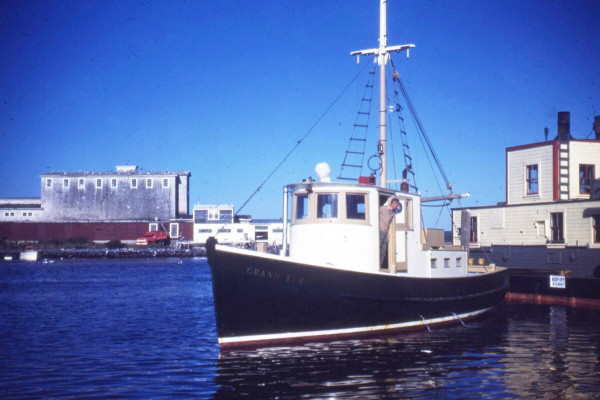
The freezer from about 1960 taken by John Cullity’s grandfather Samuel D. White.
Lisa Cavanaugh
A century ago, the largest commercial buildings on Cape Cod were most likely massive freezer plants that supported the local fishing industry.
According to historical records, in 1922 at least 14 of them dotted our coastline, from Provincetown’s East End (the building is now fancy condominiums) along the Bay to the Canal Fish and Freezing Co. at Sandwich Marina, built in 1916.
“The overall storage capacity of these freezers was 30 million pounds of fish, mostly herring, whiting, squid and mackerel,” says John Cullity, a local historian and president of the Trustees of the Sandwich Conservation Trust.
The freshly harvested fish, often caught in weirs, was conveyed to the third floor for sorting, processing and flash freezing, while the first two floors were used for frozen storage. The new industry got its start when Clarence Birdseye developed a method for quick-freezing foods where the packaged food was held under pressure between two hollow metal plates that were chilled to -25°F by the evaporation of ammonia. Using this method, a two-inch-thick package of meat could be frozen to 0°F in about 90 minutes.
Originally the frozen fish was mainly used as bait, but by the 1930s fish sandwiches had gained in popularity, particularly in the Midwest. Using refrigerated railroad cars, frozen whiting was shipped across the country in huge quantities, which in turn kept many local Sandwich residents employed at the freezer plant. According to Cullity, as many as 100 workers were on the payroll during the busy season, which ran from May to December. Both boys and girls as young as 14 worked at the plant, with girls packing the fish boxes and boys and young men moving them onto the conveyors up to the processing level.
In the 1960s, Balfour Bassett purchased the plant from United Cape Cod Cranberries and formed Canal Marine. The business operated on high volume, low value fish. “The whiting in those days was just pennies to the boat,” says Wayne Bassett, Balfour’s son, “then when herring came in, it was maybe up to 7 or 8 cents a pound.” Wayne started out at his father’s freezer plant making fish boxes out of cardboard, and remembers that the whiting they processed was used for fish ’n ‘chips in the Midwest.
The early days of Canal Marine were busy ones, with 12 to 14 boats landing every day. “The herring was right inside the Bay,” says Bassett. “We had million pound days back then.”
The Balfours operated a second freezer plant in Barnstable, and at one point in the 1970s they used it to freeze and store cranberries from local bogs. In the late 1980s the Sandwich plant even sold herring to Soviet factory ships positioned off the Massachusetts coast.
“Our shoreside businesses got the fish first of course,” recalls Bassett, “but the surplus was sold to the Russians.”
These enormous ships from the Soviet Union were given permission to purchase local herring, buoying the industry here. Canal Marine loaded fresh herring onto lobster boats that traveled up to a Soviet ship anchored outside Gloucester Harbor. Commerce with the Soviets was a boon to local fishermen who were finding herring plentiful, but buyers scarce.
“We even had one of their vessels come down into the bay because it was easier to load our frozen product aboard. It helped out everyone,” Bassett says.
Wayne ended up buying the company from his father’s estate in the 1990s, renamed it Canal Marine Fisheries, and ran it for two decades. Eventually the fish moved out of the area and the local commercial fishing industry could no longer support the large freezer plant. Canal Marine Fisheries was dissolved in 2000 and the building sold a few years later. Owners over the next decade included a company that had the tugboat contract to shepherd vessels through the canal, but the old freezer plant sat mostly unused and fell into disrepair.
Despite the signs of decrepitude, Cullity felt it stood as an important symbol of Cape Cod history. He wrote at the time in defense of the structure: “I like weather beaten old buildings, they are a genuine Cape Cod tradition that is becoming extinct. The freezer is a perfect example. There it stands, abandoned and in full view, like a symphony of weathered shingles…”
Even with his respect for structures of the past, Cullity can agree that the endeavor undertaken by two local fishermen in 2015 to transform the deserted freezer plant site into a seafood market and restaurant was inspired. Brothers Bob and Denny Colbert, who have fished out of the Sandwich Marina for more than 30 years, opened Fishermen’s View in August, 2016, with a dual focus on locally sourced seafood and a spectacular water view.
“It’s a positive thing for the town. It’s tastefully done” says Cullity.
“They took great advantage of the view,” added Bassett.
While sitting at one of the many windows facing the marina, watching boats moving through the canal, a customer can order a plate of seafood and think back to a time when one million pounds of fish a day were frozen at that exact spot.
